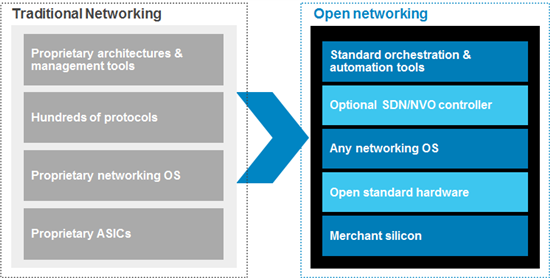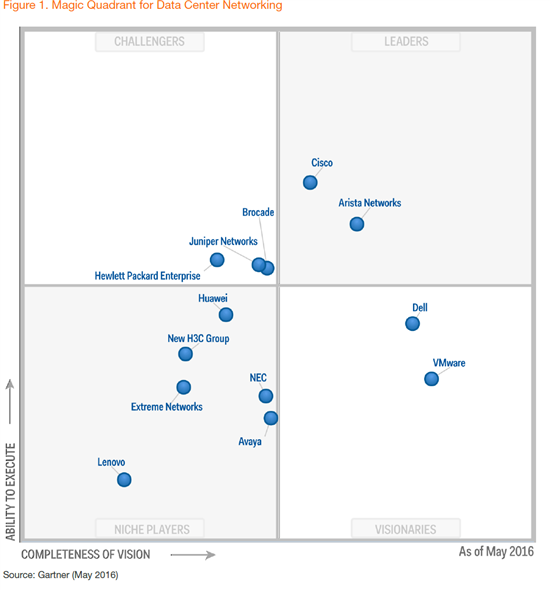Looking back, it’s hard to believe it’s been three years since we announced our Open Networking initiative in 2014. We embarked on the journey with the belief that our customers deserved more innovation and choice than they were receiving from traditional, proprietary networking vendors. At its core was a simple proposition: decouple networking switching hardware from its software. Simple, yet profound for an industry that inextricably tied, monetized and packaged hardware and software together.
Our initial step was launching the industry’s first open networking switch using the Open Network Install Environment (ONIE) and could run Cumulus Linux OS from our first ecosystem partner Cumulus Networks.
In 2015, we delivered more choice to customers by adding OS partners including Big Switch Networks, IP Infusion and Pluribus Networks and delivering a family of open networking switches with connectivity capabilities from 10 to 100GbE. Today, we are the only OEM networking player in the industry that provides this level of choice, flexibility and infrastructure protection.
In January of 2016 we introduced the latest version of our network operating system called Operating System 10 (OS10) which further “disaggregates” the networking stack by separating the base OS from the NOS. The base module of OS10 called OS10 Open Edition is offered to customers for free and runs a fully-open, unmodified Linux kernel and Debian distribution. This base is currently being tested and deployed by several customers.
In March of 2016, we announced our collaboration with Microsoft on the design and implementation of modules in the Software for Open Networking in the Cloud (SONiC) part of the Open Compute Project (OCP) to help drive industry disruption and adoption. Our OS10 Open Edition software serves as the foundational element for SONiC. From this contribution we are helping customers big and small accelerate adoption of fully-functional Linux networking software based on open source components.
That same year, we contributed OS10 Open Edition software to the OpenSwitch project, which represents a fully open, fully disaggregated base subsystem incorporating hardware and platform abstraction layers for networking switching applications.The OpenSwitch project running under the Linux Foundation aims to develop a complete open-source network OS.
In Q4 of last year we released the beta version of OS10 Enterprise Edition which provides customers with standard networking features, interfaces and scripting functions including Layer2/Layer3 protocols, policy control and traditional networking switch CLI. One of the OS10 Enterprise Edition beta customers is Indiana University who have already published their initial findings while testing our OS10 Open Edition at OS10 – A First Look.
Of the hundreds of customers now running Dell EMC open networking solutions, a key example is Verizon’s deployment of the industry’s largest known Network Function Virtualization OpenStack cloud deployment across 5 of its U.S. data centers. Dell EMC and several partners worked closely with Verizon in developing this OpenStack pod-based design that went from concept to deployment of more than 50 racks in the production data centers in less than nine months.
Another innovative customer is Netherlands-based hosting solutions company Hostnet, who implemented a Dell EMC open networking solution to help accelerate the development of their Infrastructure-as-a-Service (IaaS) and Platform-as-a-Service (PaaS) offerings using DevOps techniques. Their deployment consisted of Dell EMC open networking switches running Cumulus Linux software and Puppet automation software.
The 2016 Gartner Magic Quadrant for Data Center Networking report recognized both Dell EMC Networking and VMware companies under Dell Technologies, as the most visionary networking vendors. Together we are helping transition the industry towards a new direction in networking which IDC calls the third platform of computing, and who better to pick than the most visionary ones rather than “me too” networking vendors.
To kick off 2017, we expanded our open networking offerings into the campus environment with the announcement of our latest N-Series switches with multi-gig PoE ports, 40GbE uplink ports and support for third party OS’s via ONIE. The simplified scalability and OS flexibility offered by these new switches continues our legacy of investment protection that our customers expect and the tools needed to confidently grow their operations.
Indeed, it’s been an exciting journey over the last three years as we continue our market leadership with open networking products, partnerships and open source contributions. We aren’t finished just yet. As recent market estimates claim the use of brite boxes will explode in 2017, we at Dell EMC are leading the charge and it is our full intention to continue raising the bar for others to follow.
Looking forward, in my crystal ball I can see images that portray a continuing set of launches focused on extending our open networking vision. Some of these pictures look to me like more multi-rate 100GbE and next-generation open networking switching platforms for the data center and campus, increasing adoption of our products into service provider data centers, and even more customers and partners integrating OS10 software into their solutions.
I can honestly say that I’m more excited now than I was on that eventful day three years ago. We will continue to deliver on our promise of empowering customers with the networking choice and flexibility they need to help accelerate innovation and new services within their businesses.
For additional information on Dell’s Open Networking solutions visit our home page.

